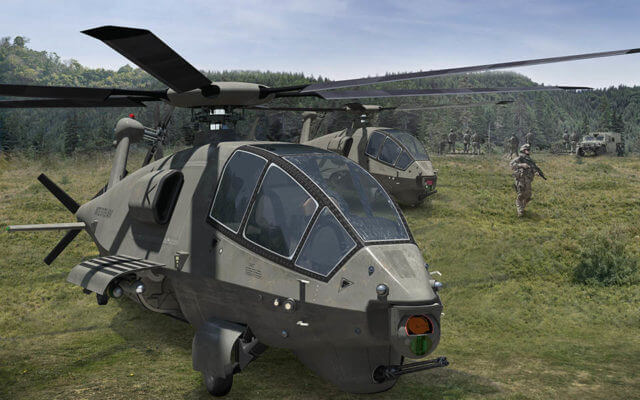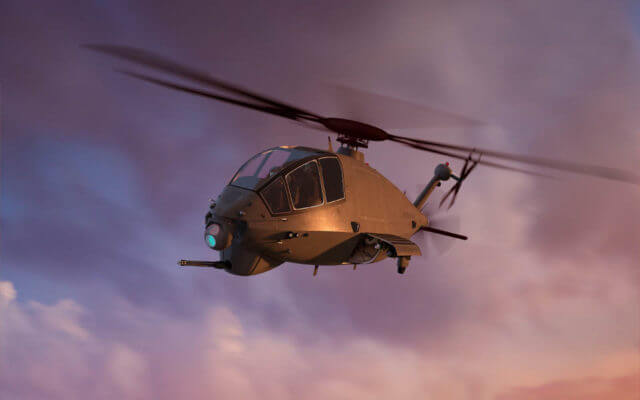Using digital design tools, Boeing has developed a thrust-compounded conventional helicopter it says is a simple, low-risk design that will meet the U.S. Army’s operational requirements for a Future Attack Reconnaissance Aircraft (FARA).
The outwardly complex design, still simply called Boeing FARA, is essentially a conventional helicopter with an aft-mounted propeller to push it at least to the Army’s 180-knot desired cruise speed. It therefore represents the novel integration of mature aviation technologies, according to Mark Cherry, vice president and general manager of Boeing’s shadowy Phantom Works.

“We see this as not an overly complex design if you think about the components . . . that have been proven out,” Cherry said. “The Army has given industry a tough problem and a set of mandatory requirements as well as desires and it’s up to industry to put together what we believe is the best configuration that maximizes their ability to meet the mission needs. All of the competitors have made that choice in terms of what those design attributes are going to bring.”
Though the company has not built a prototype of its FARA yet, digital planning coupled with component wind-tunnel testing will allow the company to begin bending metal and have a flying experimental aircraft within a relatively short time if the Army approves funding, according to Boeing officials.
“We’re not inventing new technologies for this aircraft. We are improving upon and integrating mature technologies,” Shane Openshaw, Boeing’s FARA program manager, said during a recent conference call with reporters. “Given the challenges that are on all of us to deliver next-generation capability, from a risk and schedule perspective and, in the end, a cost perspective, we believe that’s the right way to go. There’s no invention required. We’re improving and integrating mature technologies from the rotor system to the drive train, the fuselage, the landing gear, the actuation mechanisms.”
The clean-sheet-design is a hingeless, “high-solidity” single-main rotor, single-engine thrust-compounded aircraft. It has a six-bladed main rotor, a “conventional-variety” four-bladed tail rotor and four-bladed pusher propeller on the back for a total of three rotor systems. The main rotor is unique to Boeing’s FARA design, Openshaw said.

“The high-solidity rotor, think of it as a means to provide the agility and maneuverability this aircraft requires,” Openshaw said. “The tail rotor, conventionally, will give it maneuverability characteristics at lower speed of a more typical helicopter and in partnership with that propeller on the back, it will give it the speed and maneuverability needed to support the FARA requirement.”
“This has been a focused effort to define our solution to meet the capabilities for the Army,” Openshaw said. “We did not go into this effort with our mind made up on what our approach was to be. We went through an array of trades and prioritization efforts to define our solution and it is purpose-built for the Army. . . . It will be capable, simple and effective.”
The aircraft features a chin-mounted three-barrel rotary cannon below a nose-mounted ball sensor, a six-bladed main rotor, tandem cockpit configuration and a single General Electric T901 engine.
“Helicopters, by nature, are complicated machines,” Openshaw said. “What we have here is a conventional helicopter configuration with a propulsor on the tail. . . . Yes, it’s a helicopter; there will be some complexities. But, the simplicity of the design is really borne in a mature rotor system, main and tail, with a propulsor added to the configuration.”
There is a clutch in the drivetrain behind an intermediate gearbox that drives the tail rotor and adds the propeller to the configuration, he said.
Boeing’s design is not necessarily the simplest, but all five competitors have made deliberate design choices to meet Army speed and maneuverability requirements. Bell’s 360 Invictus on the surface is a conventional helicopter with single main rotor and canted, ducted tail rotor, but includes a supplemental power unit to boost it beyond 180 knots.
Sikorsky’s Raider X is a compound coaxial helicopter with dual counter-spinning rigid main rotors and a pusher prop similar to Boeing’s. AVX Aircraft’s compound coaxial helicopter sports dual ducted fans for forward thrust while Karem Aircraft’s AR-40 has a single main rotor but adds huge wings that span 40 feet and a tail rotor that swivels from a conventional orientation in helicopter mode to pusher prop at high speed.
Boeing’s FARA does not have lift-sharing wings. It carries weapons stores on internal stub wings that fold out from the fuselage to deploy.
“The focus of our effort was high-speed, low drag,” Openshaw said. “Managing the drag is an important element of being successful at operating at those speeds for whatever configuration is participating.”
Based on digital modeling and extensive wind tunnel testing, Boeing is confident it can achieve 180 knots at 4,000 feet elevation on a 95-degree F day in cruise conditions with a single GE T901 engine, Openshaw said.
“We didn’t jump to that conclusion right away,” he said. “We assessed single-engine, dual-engine, single engine with a supplemental power unit. [That was] all part of the evaluation as we determined what the optimal configuration would be to support the Army mission.”
The same goes for the tandem cockpit configuration, which provides pilots with improved sightlines within a narrow cross section and allows for common pilot interface in either position, he said.

Where some other competitors have formed teams to develop FARA designs, Boeing so far has gone it alone, though expertise in various aerospace disciplines has been drawn from internal sources, Cherry said. Its effort is being led by the secretive Phantom Works aviation laboratory with contributions from subsidiaries like Aurora Flight Sciences and AvionX.
Cherry called FARA a “one-Boeing” effort. Suppliers and any partner companies will be named later, he said.
Boeing is using the same model-based engineering that went into its successful bids to build the T-X trainer for the U.S. Air Force and the unmanned carrier-launched airborne surveillance and strike (UCLASS) that become the Navy’s MQ-25 drone. It also is drawing on lessons learned through the RAH-66 Comanche stealthy armed recon helicopter it built with Sikorsky in the 1990s, as well as the experience gained with the same partner building the SB>1 Defiant.
“That gives us assurance that we’re going to be able to meet prototyping requirements at the schedule that the Army is looking for,” Cherry said. “We’ve used our extensive background in design and testing to ensure that we have the data that supports our analysis to ensure the Army understands what we’re providing and, more importantly, all of the parameters so they can make their evaluation on the right capability for their needs.”
The teams are working under FARA design contracts awarded in April 2019. Boeing’s is worth a total $772 million, which represents the entire program through competitive prototyping. The Army will cut funding to three of the teams sometime in March, at which time the remaining two teams will build operational competitive prototypes that will go head-to-head in an Army sponsored fly-off.
“Our scheduled milestones are aligned to the Army dates,” Cherry said. “Any opportunity we have to accelerate those as we perform, we’ll assess that and make a decision as we execute the prototype phase.”
Boeing is working to meet the Army’s prototyping timelines that call for working, flying aircraft by 2022. Cherry said the model-based design should allow them to jump into build as soon as continued FARA funding from the Army is secured after the downselect.
“We are working with suppliers and partners on all components that are lead-time drivers for us today,” Openshaw said. “We have been moving out with them over the course of the last few months, as the design has matured, to make sure that we have lead-time activities covered.”









